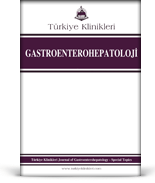Amaç: Gastrik kanserdeki olaylar dizisinin; kronik gastrit, atrofi, intestinal metaplazi, displazi ve karsinoma şeklinde olduğu kabul edilmektedir. Helicobacter pylori (Hp)nin bu kronik olaylar zincirinin başında yer aldığı bilinmektedir. Bu nedenle; Hpnin kronik inflamasyon, atrofi, aktivite derecesi, intestinal metaplazi ve bcl-2 ile ilişkisini araştırdık. Gereç ve Yöntemler: Çalışmaya alınan toplam hasta sayısı 52 olup; 35i kadın (%67.3), 17si erkek (%32.7) hastadan oluşmaktadır. Kadınların yaş ortalaması 44.5; erkeklerin yaş ortalaması ise 41.5 olarak tespit edildi. Tüm olgularda %53.8 oranında Hp saptandı ve tüm olgularda kronik inflamasyon bulundu. Olgularımızda displazi ve gastrik Ca saptanmadı. Hp saptanan hastalarda atrofi oranı %82.1; İM oranı %25; nötrofil aktivite oranı %89.3 bulundu. Hp (-) hastalarda atrofi oranı %37.5, İM oranı %8.3, nötrofil aktivite oranı %8.3 bulundu. Hp yoğunluğu ile kronik inflamasyon derecesi, atrofi derecesi ve aktivite derecesi arasında istatistiksel olarak anlamlı olmak üzere (+) korelasyon görüldü. Bulgular: Hp saptanan hastaların %7.1inde bcl-2 (+) bulunurken, Hp (-) hastaların %4.1inde bcl-2 (+) bulundu. Ancak, Hp (+) kronik atrofik gastritli 23 hastanın 2 (%8.7)sinde bcl-2 (+) iken, Hp (-) kronik atrofik gastritli 9 hastanın 1inde (%11.1) bcl-2 (+) bulundu. Yani Hp (-) kronik atrofik gastritte, Hp (+) kronik atrofik gastrite göre daha fazla bcl-2 (+)liği görüldü. Hp (+) saptanan bcl-2 (+) 2 olguda da atrofi ve İM birlikteliği görüldü. Atrofide bcl-2 (+)liği %9.3 iken; İMde ise %22.2 bulundu. Sonuç olarak İMde atrofiye göre oransal olarak daha fazla bcl-2 (+)liği görüldü Bu verilere göre, oransal olarak bcl-2 (+)liği Hp (+)lerde daha fazla bulunmasına rağmen, istatistiki olarak anlamlı bulunamadı. Yine, bcl-2 (+)liği ile atrofi arasında istatistiksel verilere göre anlamlı bir fark bulunamadı. Bu durum olgu sayısının fazla olmamasına bağlandı. İM ile bcl-2 arasında ise istatistiki olarak veriler anlamlı bulunmuş olup, aralarında (+) korelasyon saptanmıştır. Sonuç: Bu verilerden; Hp enfeksiyonunun kronik gastritle sonuçlandığını, atrofi, İM gelişiminde önemli bir rolü olduğunu ve Hp enfeksiyonunun nötrofil aktivasyonu ile anlamlı bir ilişkisi olduğunu saptadık. Hp yoğunluğu arttıkça kronik gastrit derecesi, aktivite derecesi ve atrofi derecesi arttırdığını gördük. Apoptozisi arttırdığı bilinen Hpnin, direkt olarak değil de, indirekt olarak atrofi oluşumuna yol açarak antiapoptotik bir gen olan bcl-2 ekspresyonunu da arttırdığını tespit ettik. İMde atrofiye göre daha fazla bcl-2 (+)liği gördük. İstatistiksel oranların anlam kazanması ve gastrik kansere doğru ilerledikçe bcl-2 ekspresyonunun arttığını desteklemek için, displazik ve gastrik Calı hastaları da kapsayacak şekilde, geniş olgu serili çalışmalara ihtiyaç vardır.
Anahtar Kelimeler: Helicobacter pylori, intestinal metaplazi, gastrik atrofi, bcl-2
Objective: Its assumed that, the occurrence series in gastric cancer is as following; chronic gastritis, atrophy, intestinal metaplasia, dysplasia, and carcinoma. Its known that Helicobacter pylori (Hp) is around the chain of these chronic phenomena. Therefore, we studied the relation of Hp with chronic inflammation, atrophy, activity level, intestinal metaplasia and bcl-2. Material and Methods: The number of the patients included in this study was 52; 35 (67.3%) of them were female and 17 (32.7%) of them were male. The average ages of women and men were determined as 44.5 and 41.5, respectively. Hp was determined in 53.8% of all cases and chronic inflammation was found in all cases. No dysplasia or gastric cancer was found in our cases. Among the patients that Hp was found in, the rate of atrophy was 82.1%, the rate of IM was 25%, and the rate of neutrophile activity was 89.3%. These rates were found as 37.5%, 8.3% and 8.3%, respectively, among the Hp negative patients. A statistically remarkable positive correlation was found between the Hp intensity and the degrees of chronic inflammation, atrophy and activity. Results: Bcl-2 was found positive in 7.1% of the patients with Hp, and in 4.1% of the Hp negative patients. However, bcl-2 was positive in 2 (8.7%) of 23 Hp positive patients with chronic atrophic gastritis and it was also positive in 1 (11.1%) of 9 Hp negative patients with chronic atrophic gastritis. In other words, bcl-2 was found more in Hp negative chronic atrop-hic gastritis than Hp positive chronic atrophic gastritis. Also, atrophy and IM were together in 2 bcl-2 positive patients that Hp was positive. bcl-2 was positive in 9.3% of the patients with atrophy and in 22.2% of the patients with IM. Therefore, bcl-2 was found positive more in IM than atrophy, proportionally. According to these data, although bcl-2 was found positive more in Hp positive ones proportionally it was not statistically remarkable. Nevertheless, no remarkable difference was found between bcl-2 positiveness and atrophy according to the statistical data. The data between IM and bcl-2 were found statistically remarkable and a positive correlation was found between them. Conclusion: We concluded these data as following; Hp infections results in chronic gastritis, it has a role in developments of atrophy and IM, and Hp infection has a remarkable relation with neutrophile activation. The more Hp intensity gets high the more the degrees of chronic gastritis, activity and atrophy increase. We also found that Hp, which is known to increase apoptosis, increases the expression of the bcl-2 that is an anti-apoptotic gene not directly but by causing atrophy development. We observed more bcl-2 positiveness in IM than atrophy. The studies with extensive series of cases including the patients with dysplasia and gastric cancer are needed to gain sense to statistical rates and to support the suggestion that bcl-2 expression increases with the progression of gastric cancer.
Keywords: Helicobacter pylori, intestinal metaplasia, gastric atrophy, bcl-2







.: Process List